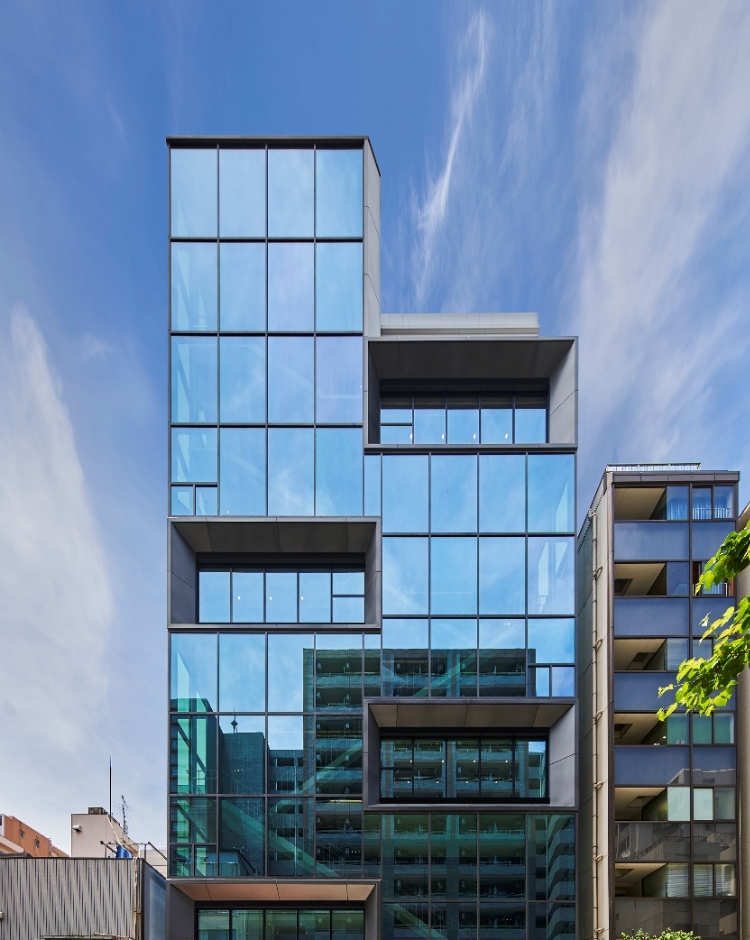
the Shinryo Shinjo Building
The Shinryo Shinjo Building is located in the center of the city, but the environment technology introduced, such as maximizing the use of natural energy through the development of original technology, has been evaluated at the world level.
Overview of the
Shinryo Shinjo Building
Floor 1
Floors 3 to 5
Floors 6 to 8
Each floor
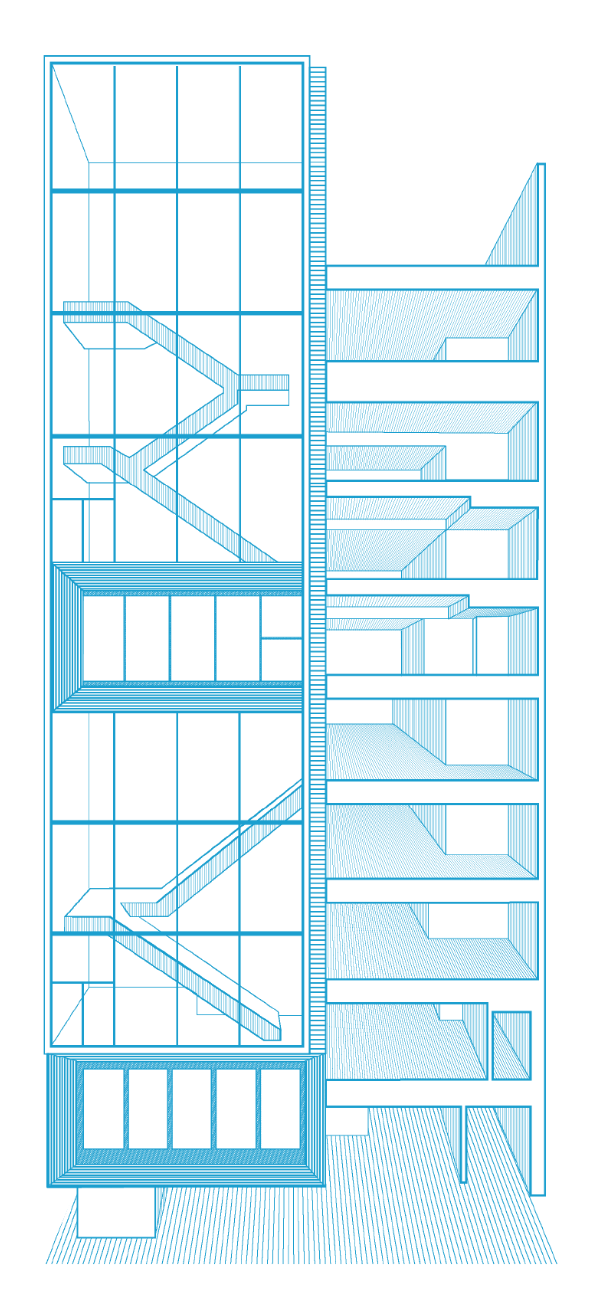
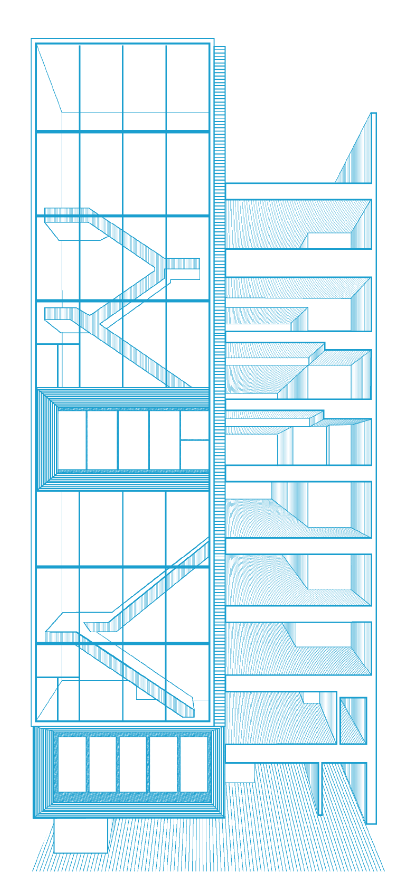
Building overview
Shinryo Shinjo Building features
Ductless air conditioning is used throughout the building to secure one additional floor of space.
We developed an original dynamic range radiant air conditioning system that overcomes the weaknesses of past radiant air conditioning in order to maximally utilize natural energy.
We used original technology to resolve the problem of Coanda air conditioning system having too little reach when using a small air volume and also reduced the energy consumption.
Shinryo Shinjo Building feature 1
Space +1 floor
Using newly developed original ductless air conditioning throughout the building to secure one additional floor of space
The office floors (floors 3 to 8) use two types of originally developed ductless air conditioning, which enable major energy savings compared to past air conditioning, particularly during times of non-extreme temperatures when air conditioning is not required.
Thanks to the above and ductless air conditioning throughout the rest of the building, we were able to achieve +1 floor through the realization of a lower floor height while ensuring the same ceiling height.
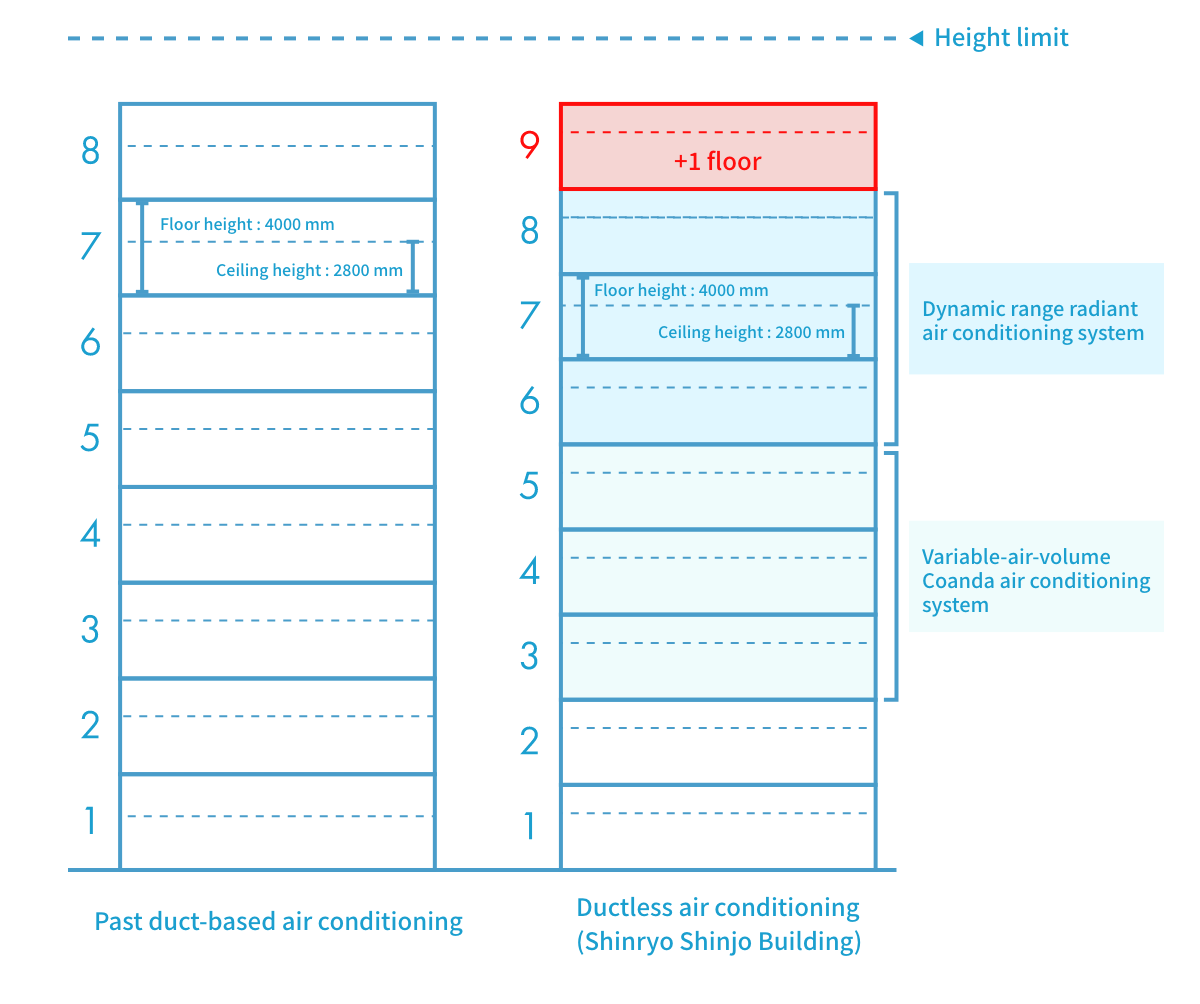
Shinryo Shinjo Building feature 2
Development of original,
highly energy efficient technology for
ductless air conditioning
Dynamic range radiant air conditioning system
Our new dynamic range radiant air conditioning system combines technologies that include variable flow control and variable temperature difference control that optimize the temperature range according to the heat load and a pre-cool cooling tower that uses outside air to cool water in order to maximally utilize natural energy.
Natural energy is utilized for approximately 70% of the annual cooling hours.
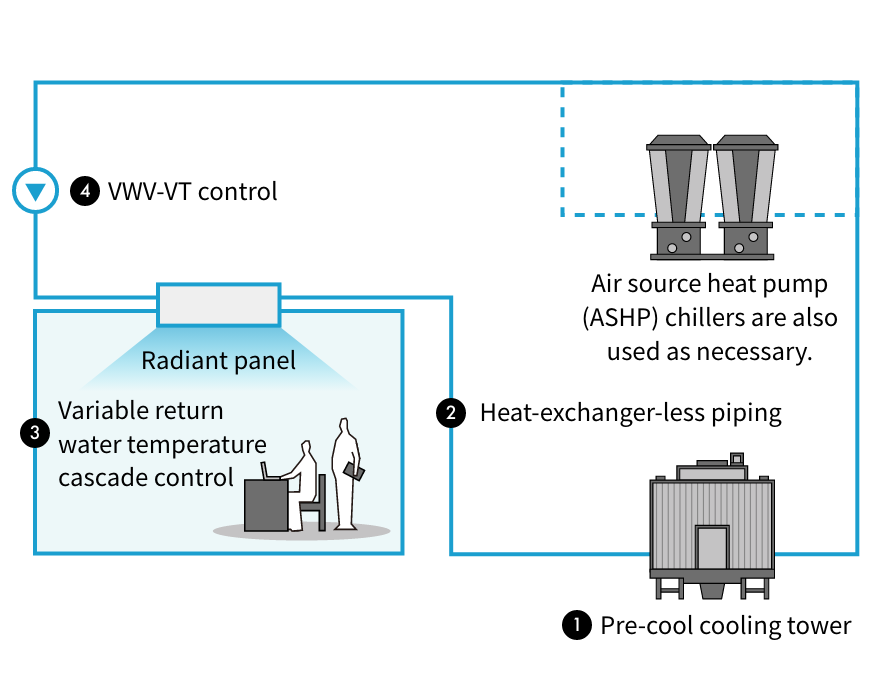
Issues related to past water-type radiant air conditioning systems
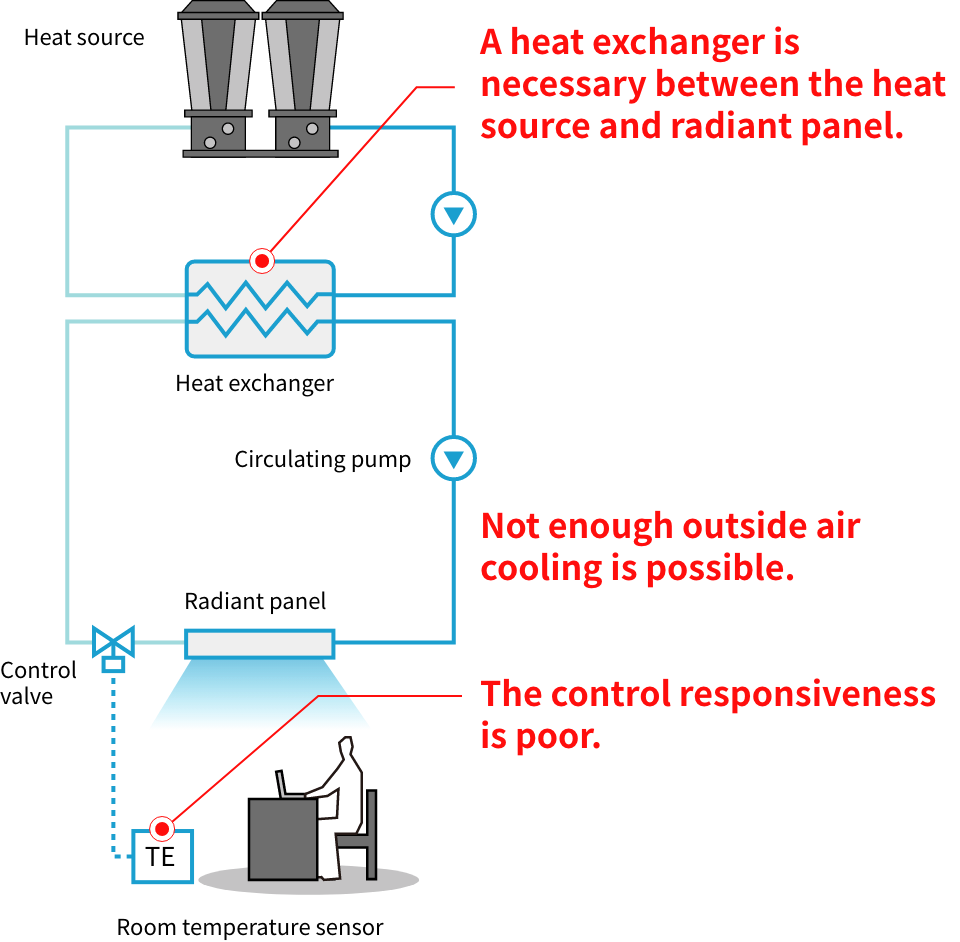
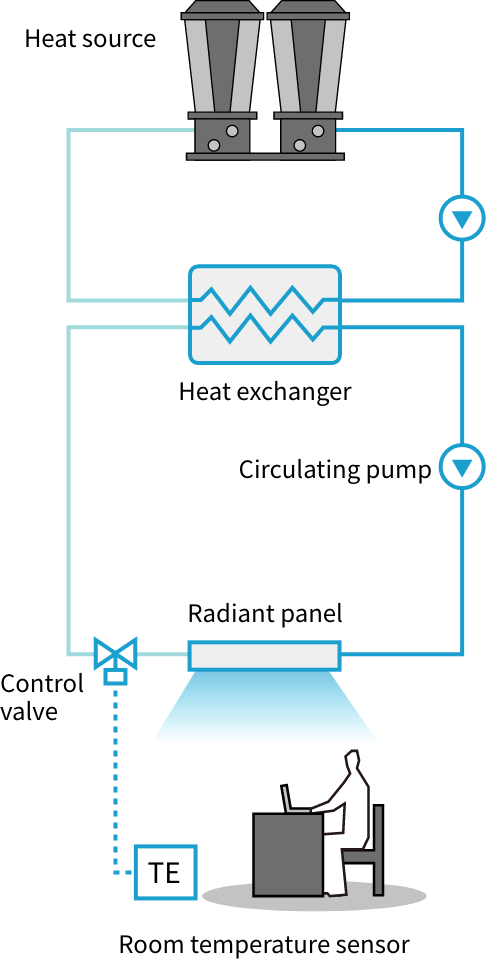
A heat exchanger is necessary between the heat source and radiant panel.
A heat exchanger is introduced to prevent the corrosion of piping and equipment due to the penetration of oxygen from the radiant panel’s resin tubes.
→ Increased water flow resistance on both the primary and secondary
sides
→ An approach is necessary for the heat source manufacturing temperature.
→ A low-efficiency constant flow circulating pump is necessary.
There are nothing but disadvantages in terms of energy savings.
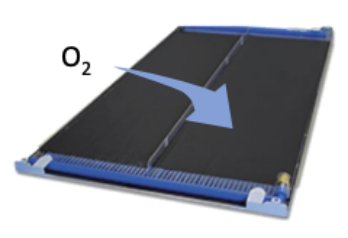
Not enough outside air cooling is possible.
Due to cost problems and space constraints, only the minimum necessary amount of outside air is included in the plan. In addition, there are constraints on the conditions for introducing outside air due to the need to reduce radiant panel condensation.
The control responsiveness is poor.
It tends to cause control instability by repeatedly overshooting due to the delay between the change in the flow rate and the response of the room temperature.
→ Overshoot repeatedly occurs, causing a situation similar to on/off control.
Original technology that resolves issues
Pre-cool cooling tower
By combining this tower with the newly developed control described below, we greatly expanded the natural energy utilization period compared to past free cooling systems.
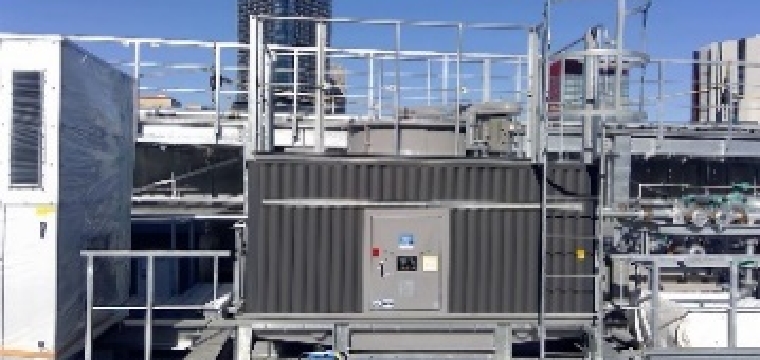
Non-chemical corrosion prevention system
Although radiant panels that use resin tubes are lightweight and offer high heat transfer performance, they also have a problem with oxygen penetration, so a heat exchanger is generally installed to prevent the corrosion of piping and equipment.
However, we achieved a piping system with no need for heat exchange by combining Shinryo Corporation’s original non-chemical corrosion prevention system Corro-Guard® with deoxidation equipment. By not installing a heat exchanger, we improved the energy efficiency, such as by reducing the water flow resistance and eliminating the need for a circulating pump.
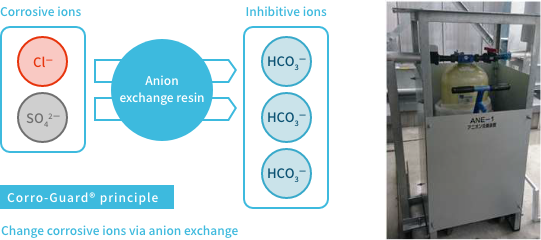
Return water temperature cascade control
In the case of methods involving room-temperature-based control of the radiant panel flow rate, there is often time lag that makes control unstable. Our newly developed method, which controls heat dissipation with the return water temperature, reduces overshoot and improves the control responsiveness.
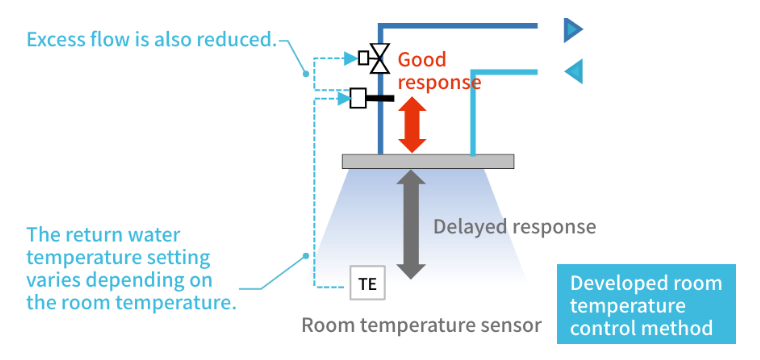
VWV-VT control
When the load decreases, the water supply temperature is increased accordingly based on the return-water-temperature setting value information. When there is a partial load, the temperature difference is decreased and the system is shifted to a higher temperature range in order to expand the precool cooling tower’s usage period, improve the heat source COP, reduce the heat dissipation from piping, and otherwise improve the energy-saving performance of the system as a whole.
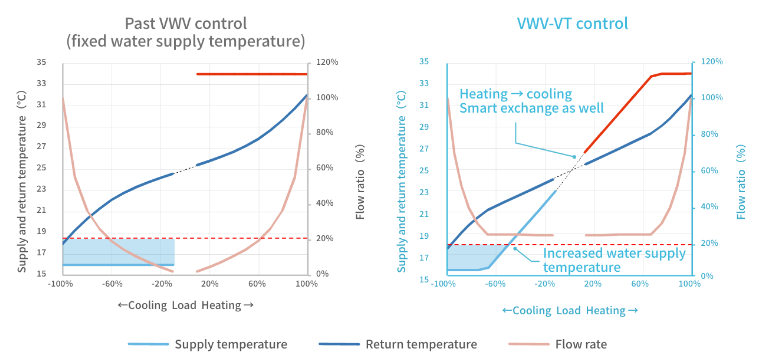
Coanda air conditioning system
Our ductless variable-air-volume Coanda air conditioning system uses the Coanda effect to create a jet of air flowing along the ceiling, which eliminates the need for duct space in the ceiling to enable a shorter floor height.
This system realizes greater energy savings of blower power used in combination with Air-Soarer®* constant autonomous airflow outlets that can deliver uniform airflow—including both the air conditioned air and fresh outside air—to every corner of the room, regardless of the strength of the airflow.
Air-Soarer® was jointly developed by Mitsubishi Jisho Design Inc., Shinryo Corporation, Shibaura Institute of Technology, and Kyoritsu Air Tech Inc.
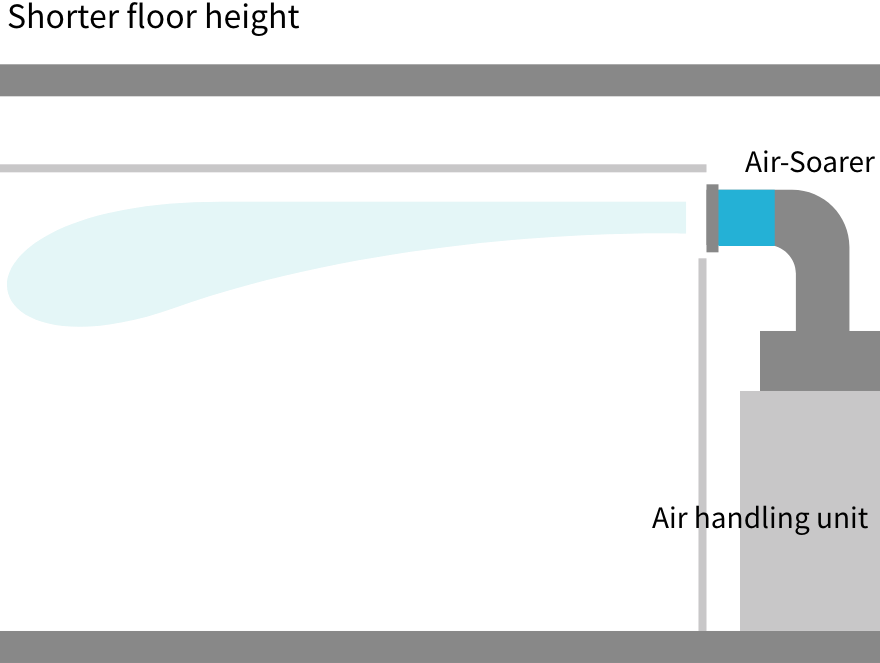
Issues related to past Coanda air conditioning systems
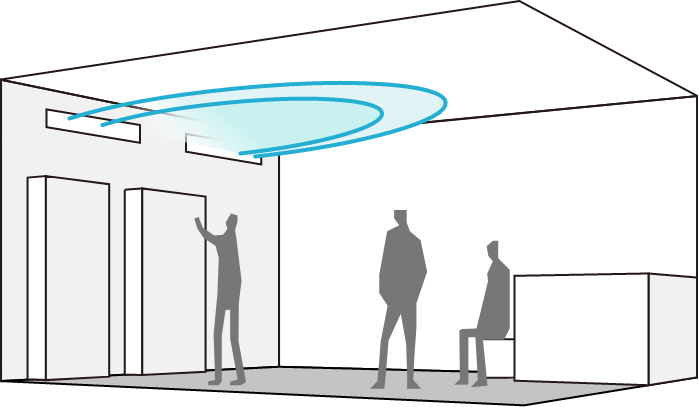
As shown in the figure on the left, Coanda air conditioning system uses the Coanda effect—the phenomenon of air blown toward the ceiling moving along its flat surface—to deliver air-conditioning air without using ducts.
With past Coanda air conditioning systems, reduced air volume resulted in less reach, which made it difficult to utilize highly energy efficient variable air volume control, and such systems therefore did not necessarily achieve high energy savings.
Original technology that resolves issues
Air−Soarer
Air-Soarers are constant wind speed devices that enable variable-air-volume Coanda air conditioning.
When there is a lot of air volume, the air pressure results in a larger opening area, and when there is little air volume, the considerable effect of the moment of weight reduces the opening area. There is no sensor or electricity use, and the reach is maintained by keeping the blowing wind speed constant even when the air volume changes.
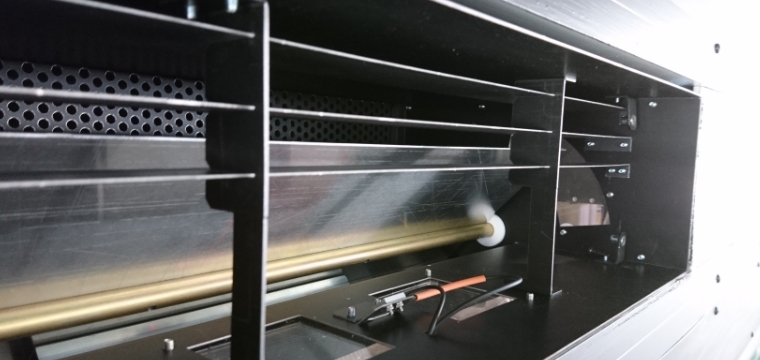
Higher energy savings through the use of variable air volume
Our variable-air-volume Coanda air conditioning system resolves the issue of the reach being insufficient when the air volume is reduced and enables variable air volume control to reduce the required conveyance power by 65% compared to past constant-air-volume duct-based air conditioning systems.
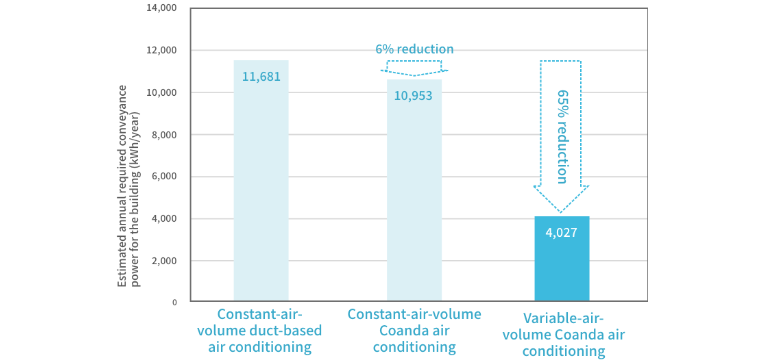
Shinryo Shinjo Building feature 3
Advance verification of the effects of developed technologies by using the full-scale mock-up at our company’s Innovation Hub
At our company’s Innovation Hub, we built a full-scale mock-up equivalent to one span of the Shinryo Shinjo Building, and we conducted various verification tests and experiments and then applied the results to the design and construction site in order to reliably convert developed technology ideas to practical technologies.
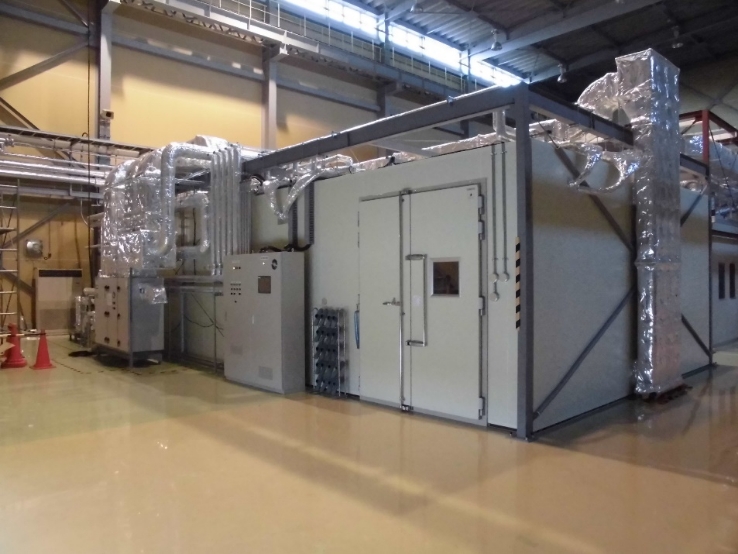
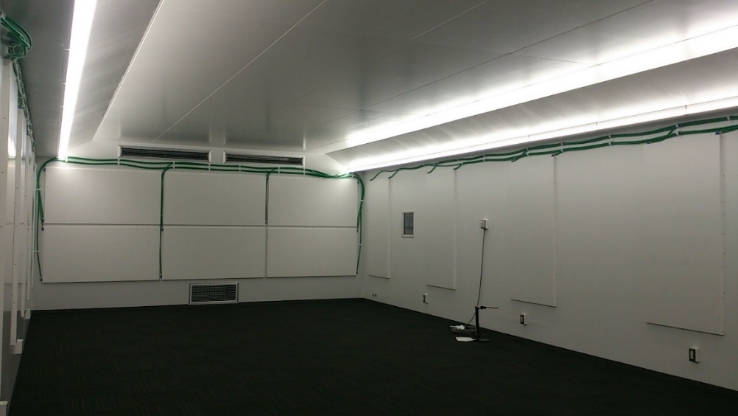
Demonstration experiments
Dynamic range radiant air conditioning system
- Testing the stability of developed radiation capacity control and establishing control parameters
- Verifying VWV-VT control characteristics
- Verifying the radiant panel startup time
- Measuring the amount of oxygen penetration from the radiant panel’s resin tubes
Variable-air-volume Coanda air conditioning system
- Constant wind speed devices: measuring the wind speed profile
- Constant wind speed devices: Eliminating hysteresis
- Constant wind speed devices: Verifying reach differences depending on conditions
- Constant wind speed devices: Verifying variable wind speed effects with an actuator
- Constant wind speed devices: Testing standalone performance
- Constant wind speed devices: Measuring pressure loss and noise
- Constant wind speed devices: Considering the optimal air outlet size and aspect ratio
- Testing the thermal environment during heating
- Considering methods for eliminating heat accumulation directly under air outlets
- Confirming the effects of mutual airflow between air outlets
- Verifying the airflow diffusion
- Confirming consistency with computational fluid dynamics (CFD) analysis that considers radiation
- Verifying airflow properties via CFD analysis
- Considering air blowing methods and thermal comfort via subject-based experiments
- Evaluating thermal comfort via thermal manikin experiments
- Effects of the ceiling finish and ceiling obstacles on airflow properties
- Considering CFD analysis methods by using BOX and PV methods
Performance verification
Dynamic range radiant air conditioning system
Based on the radiant-panel capacity characteristics for dynamic range radiant air conditioning, we used an actual panel to gain an understanding of the control characteristics in advance, specifically in terms of the stability of return water temperature control and effectiveness of VWV-VT control.
Regarding the expanded utilization of natural energy—one of our development objectives—we achieved a measured performance of 68%, which was just shy of our predicted performance of 70%.
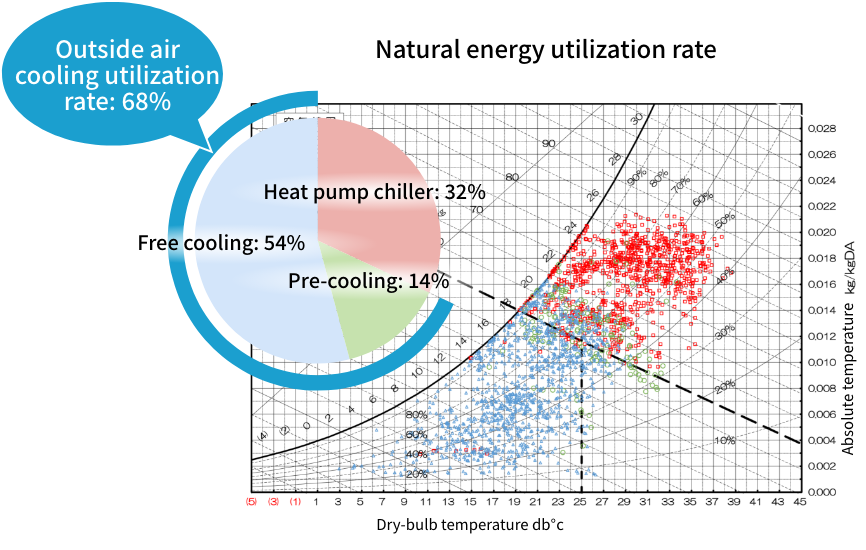
Variable-air-volume Coanda air conditioning system
In terms of variable-air-volume Coanda air conditioning system—regarding the airflow along the ceiling surface, which demonstrates the Coanda effect—we used mock-ups to repeatedly conduct full-scale experiments during which we measured values and applied them to our CFD analysis to improve our predictive precision, and we also focused on conducting actual measurements at the building to gain an understanding of the actual airflow properties.
Although we could not achieve a perfect temperature distribution match due to a certain degree of variance in measurement and analysis conditions, we were able to obtain a fairly consistent match with the locations where the air-conditioning airflow—an important element of Coanda air conditioning system—detaches from the ceiling.
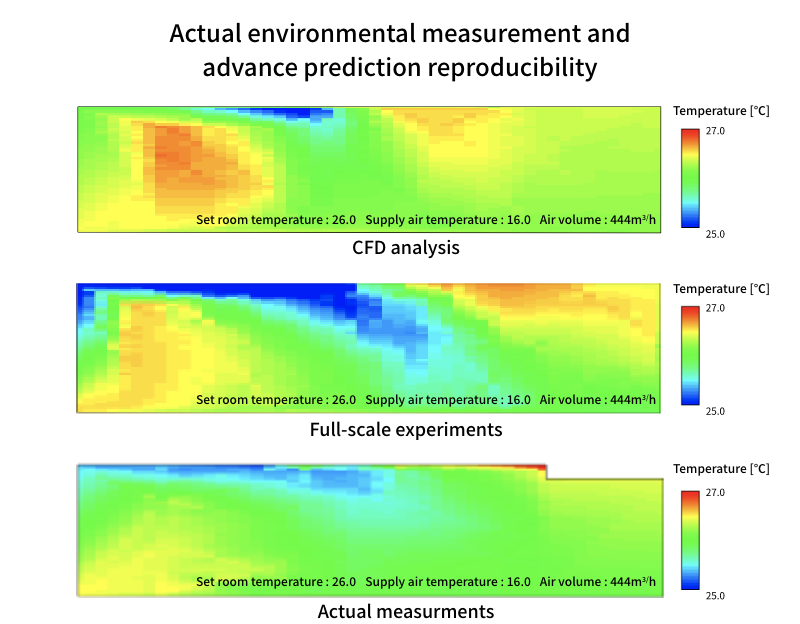
Shinryo Shinjo Building feature 4
Taking on the challenge
of decarbonization
Providing new decarbonization technologies
Shinryo has been providing technologies that help to reduce greenhouse gas emissions (Scope 3: Category 11) produced by running building equipment after it is delivered to customers. Society is taking significant action to achieve decarbonization and demands new technologies to help do so.
For the construction of the Shinryo Shinjo Building, Shinryo Corporation collaborated with Mitsubishi Jisho Design Inc. and Shibaura Institute of Technology (Professor Takashi Akimoto) in an effort to research and develop decarbonization technologies starting at the planning stage. To embody ideas obtained during our consideration of technical issues and solutions, we have established new technologies by conducting CFD analyses, full-scale experiments, and actual measurments.

Achieving ZEB Ready requirements
By introducing various decarbonization technologies, we reduced the primary energy consumption by 54% compared to the base value at the design stage to achieve the ZEB Ready requirements. Based on the performance during the first fiscal year of operation, this reduction was improved to 75%.
In addition, Shinryo also continuously strives to increase energy savings after the completion of construction, such as by developing and introducing optimal heat source control systems through linkage with spreadsheet software.
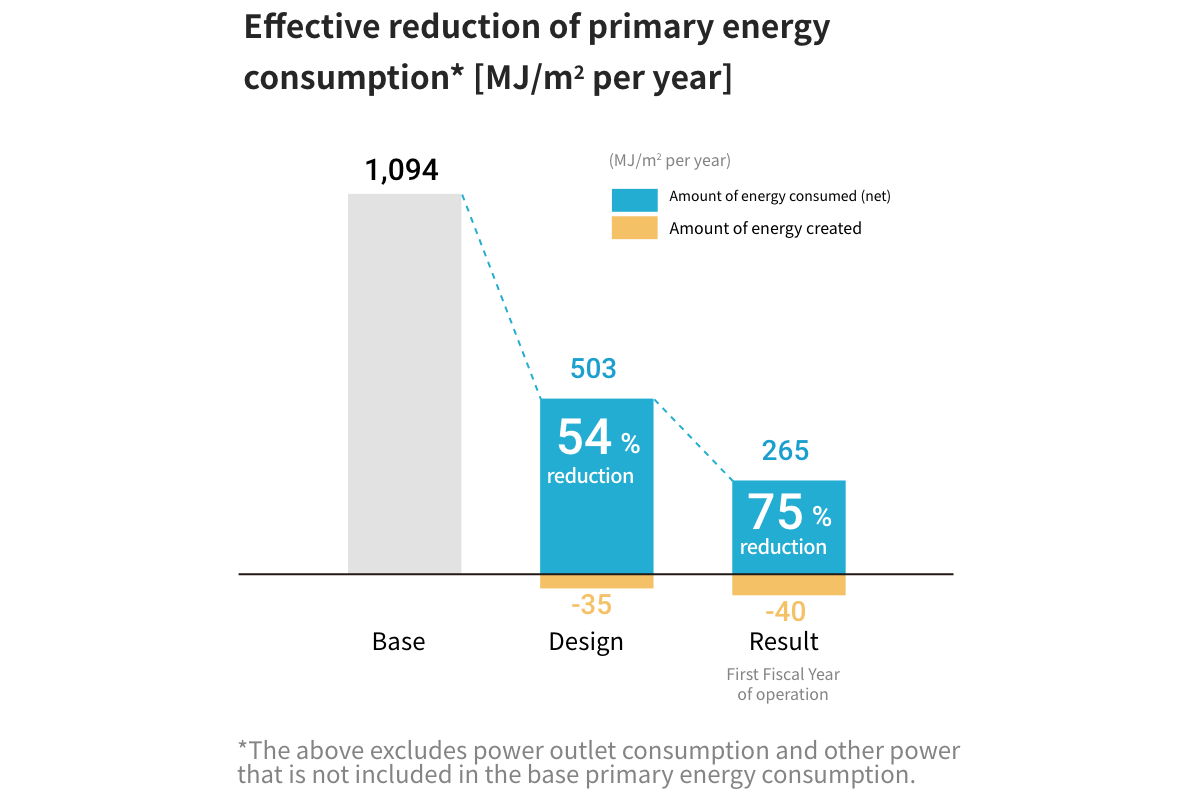
Shinryo Shinjo Building feature 5
Major awards and achievements
2023 ASHRAE Technology Awards, First Place
2023 ASHRAE Region XIII Technology Awards, First Place
2022 ASHRAE Japan Chapter Technology Awards, First Place
60th SHASE Awards for Distinguished Technologies
10th Carbon Neutral Awards Kanto Branch
18th/20th Environmental and Equipment Design Awards (total of three awards)
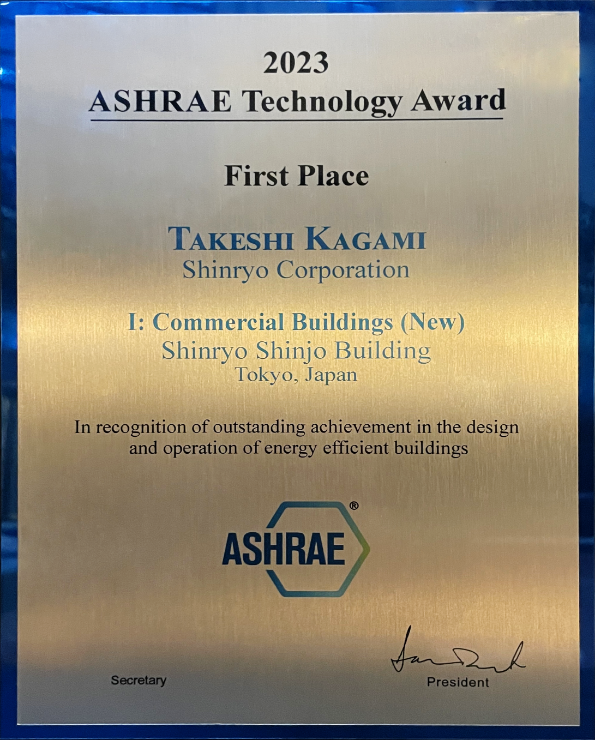
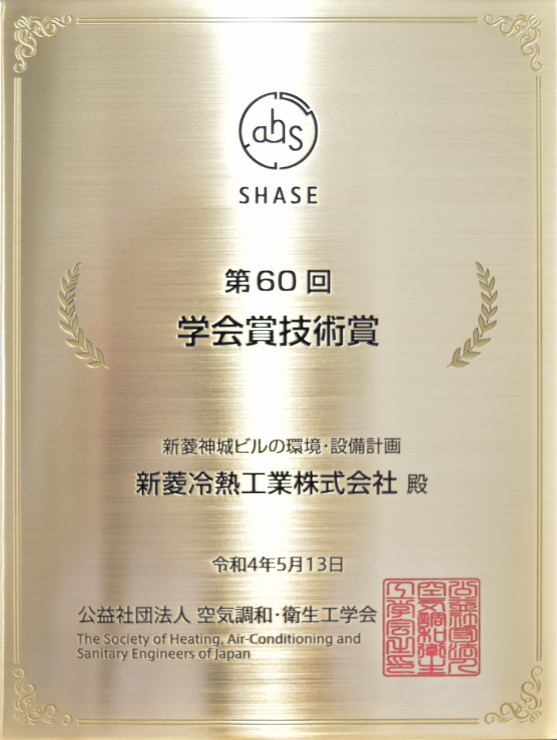
If you are considering
environmental engineering solutions and services
Shinryo can help.
If you would like to talk to us about introducing technologies or our services or have any questions, please do not hesitate to contact us below.
Contact Us